Mask
The Everyday Use of Masks,
the Ideal of Masked Plays
01. Different Narratives(다른 이야기)
Mask plays are dramas in which performers wear masks.Some argue that masks are nothing more than facades, and that mask plays are, in essence, mere performances. However, watching one might spark the thought: does wearing a mask make my portrayal any less genuine? Could it be that the sentiments expressed behind a mask are those too raw, too true, to be shown otherwise? Perhaps they encompass the authentic happiness we all chase? At their heart, aren't mask plays tales of souls seeking joy?
In the mask plays of the three East Asian countries—Korea, China, and Japan—there's an underlying commonality in their origins and evolution. Yet, they diverge subtly, much like our distinct faces, languages, and cultures. These plays satirize society, stir emotions with heroic tales, and greet the dawn with dances that mimic the divine. As we listen to the varied voices from behind these masks, we come to understand the genuine yearnings they harbor: unguarded confessions, dreams of heroism, and prayers offered to the divine, all expressed from behind a mask.
1-1. Narratives of Harmony(어우러짐의 이야기)
Korean mask plays is also called 'Tallori(Mask Dance Drama). As the name 'nori' indicates, Korean mask plays refers to a deviation from work and rest from forgetting daily pain. Therefore, the story of the mask plays aims for a happy ending that heals the hardships of the reality that most audiences are experiencing. The servant 'Maltugi' teases the owner 'Yangban', 'Chwibari' takes away the lover of 'Nojang', and 'Halmi' complains to 'Yeonggam', who has a concubine. By revealing the sadness and resentment of ordinary people without hesitation and wit, it gives them the power to heal their resentment and return to daily life and work. However, this conflict ends with reconciliation, not a catastrophe. The highlight of the masque lies in this happy ending. Each story ends with people in confrontation dancing together, and the playground is filled with exciting energy as the unmasked performer and the audience hang out and play. The playground where the masque is played is an open space that is accepted and a world where everyone is together, no matter what social conventional wisdom is overturned.① Street Parade — A Prelude to the Masked Play(길놀이 - 가면극의 예고편)
Exciting sounds of "kkwaenggwari" and "janggu" resonate throughout the neighborhood, marking the beginning of the mask plays. A flag bearer(旗手), a person wearing a mask, and a person who stimulates excitement by playing "kwaenggwari" roam around the village and market in a row. Sometimes, they enter the house to remove liquid(厄) and perform ‘Jishinbalgi’ to give blessings(福). The appearance of masked performers dancing to their respective roles is like a preview of the mask plays that will unfold in the future.
Street Parade-Yangju Byeolsandae Nori and Hahoe Byeolsingut Tallori


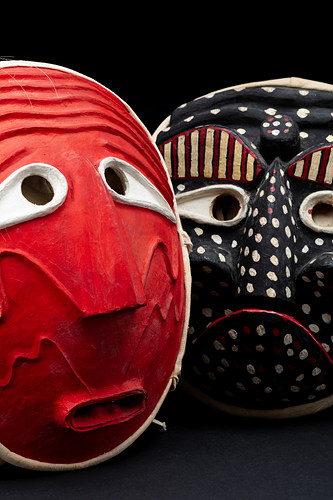
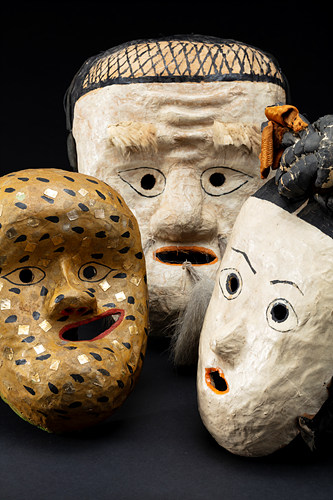
Street Parade-Yangju Byeolsandae Nori and Hahoe Byeolsingut Tallori
② Yangban and Malttugi(양반과 말뚝이)
In Korean mask plays, the story of Yangban and Maltugi unfolds, which reveals dissatisfaction with society through a confrontation structure between the social strong and the weak. The story, which tactfully captures the reality of the time, such as the fall of the Yangban class, the conflict of status, the confusion and contradiction of social norms, varies in names depending on the Korean mask plays, but it is usually called "Yangban Gwajang".
Malttugi-Goseong Ogwangdae(late 20th century)
Malttugi-Suyeong Yaryu(21st century)
Malttugi-Dongnae Yaryu(early 20th century)

Mo Yangban-Dongnae Yaryu(21st century)
Hongbaek Yangban-Goseong Ogwangdae(late 20th century)
Biteul Yangban-Tongyeong Ogwangdae(early 20th century)
③ Nojang and Chwibari(노장과 취발이)
"NojangGwajang", which is commonly performed in Korean mask plays, reflects the social situation of the late Joseon Dynasty, where the suffering of the common people is increasing due to the harm of the rich system. The monk masks in the mask play are a comparison of those who are free from the burden of rich roles and taxes and wander aimlessly. The story consists of the process of an old man who is praised as a virtuous monk breaking away from a young and pretty "Somu" and losing "Somu" to a young and powerful "Chwibari".
Chwibari-Yangju Byeolsandae Nori(20世紀後半)
Nojang-Yangju Byeolsandae Nori(20世紀後半)
④ Yeonggam and Halmi(영감과 할미)
In Korean mask plays, "YeonggamGwajang," where "Yeonggam" and "Halmi" cause conflict over the issue of a child or concubine, is performed nationwide. The story is about "Yeonggam" persecuting "Halmi" because they did not take good care of their children or because of their concubine, although "Halmi" is persecuted. In such an unfair marital relationship, "Halmi" does not just stand still. They also declare that she runs away from home to "Yeonggam," who persecutes her, and proudly demand the division of her property. However, the ending usually ends with the death of "Halmi." The "Gut" or funeral procedures that take place after death are a ritual to release the resentment of "Halmi" and are placed at the end of the mask play to release the hearts of the viewers together.
Miyal Halmi-Bongsan Talchum(미얄할미, 20世紀半ば)
Yeonggam-Bongsan Talchum(영감, 20世紀半ば)
Deolmeorijip-Bongsan Talchum(덜머리집, 20世紀半ば)
1-2. Narratives of Hero’s(영웅의 이야기)
Chinese mask play is called ‘Nuoxi(傩戏)’. Depending on the region and ethnic group, the names vary, including Nuotangxi(傩堂戏), Dixi(地戏), Guansuoxi(关索戏), and Shigongxi(师公戏). As many ethnic groups live in a vast territory, the world they dream of is diverse, so not only the types and forms of masks, the content and progression of the play, but also the stories of the mask play are diverse. However, there is something in common that the story of the hero as the main character unfolds in a variety of ways. In the mask play, heroes exist in many forms. He is also an ordinary neighbor, such as Panguan(判官), a mythical god that grants human wishes, a difficult person who lived in history such as Guan Yu(关羽), a protagonist in a novel such as Sunwukong(孙悟空), an ancestor of ethnic groups such as Abumo(阿布摩), and sometimes even Mengjiangnu(孟姜女).① The story of God's Who fulfilling one's wishes-Guizhousheng TongrenDiqu Dejiangxian Nuothanxi(사람의 소원을 들어주는 신 이야기-귀주성(贵州省) 동인지구(铜仁地区) 덕강현(德江县) 나당희(傩堂戏))
Various ethnic groups live in the northeastern part of Guizhousheng, China, and various mask play are handed down. In particular, TongrenDiqu(铜仁地区)Dejiangxian(德江县) Nuothanxi(傩堂戱) is called the 'living fossil' of Chinese mask play. It is usually performed when there is a request from a person who wants Nuothanxi(傩堂戱) after the Ipdong(立冬, Onset of Winter). Usually, when there is a difficulty such as getting sick, having no children, or suffering a disaster, they call the God through laoshi(老师, shaman) to pray for the ghost to cure the disease, get children, and get rid of the disaster. Then, the God drives away the ghost, cures the disease, occupies the child, and eliminates the disaster. In Dejiangxian(德江县) Nuothanxi(傩堂戱), a mask is the God and a hero who protects people.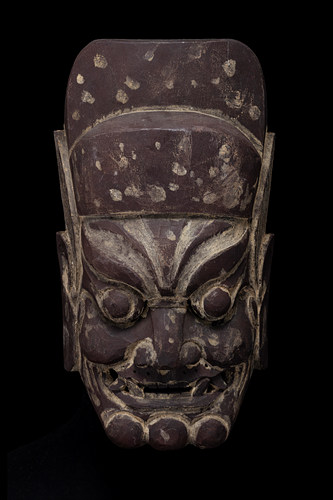
Panguan(判官)
late 20th century He judges the sins of the dead; he gives long life to the good, and punishes to the bad.
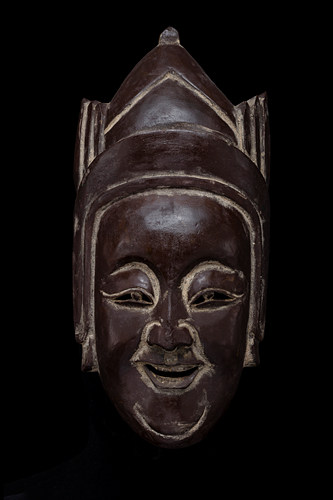
Xianfeng(先锋)
late 20th century A female general who defeats evil and brings wealth
② The story of a neighbor(곁에 살고 있는 이웃의 이야기)
Nuoxi(傩戏, Chinese mask play) stories that give ethical and moral lessons are performed while describing the lives of ordinary people based on folk legends that have been handed down since ancient times. In this way, the stories of neighbors and ordinary people living next to them function to relieve tension and entertain by showing the realistic and familiar human world away from the religious and sublime worldview of the God and heroes.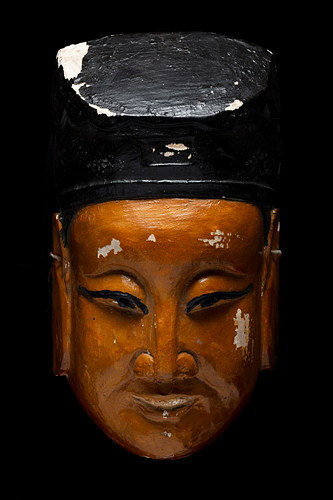
Gansheng(甘生)
late 20th century A student preparing for an examination to become an official
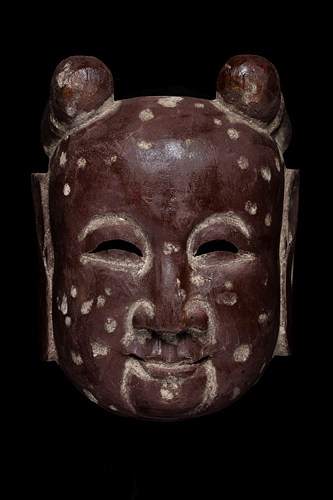
Anan(安安)
late 20th century He is a representative filial character in China. He brings food to his mother, who was cast out after being framed.
③ The story of the god of ancestors(조상신 이야기)
Mask plays of ethnic minorities such as the Yizu(彝族) and Baimazangzu(白马藏族) are performed as one of the seasonal customs, and since they contain the myth and history of the people, many masks depicting the ancestors appear. In the stories of singing in their language, the identity of each nation and the value of life they value. The value comes not only from their ancestors, but also from generations to generations, it is a lesson of life.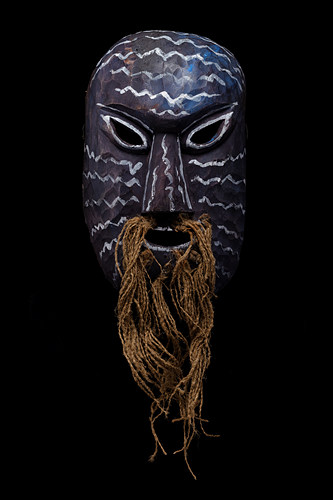
Abumo(阿布摩)
late 20th century An ancestral mask of the Yizu(彝族, a minority ethnic group that lives in Weiningxian(威宁县), Guizhousheng(贵州省)), Abumo(阿布摩) meaning "grandfather" with the name of 彝族語. He is said to be 1,700 years old, according to legend.
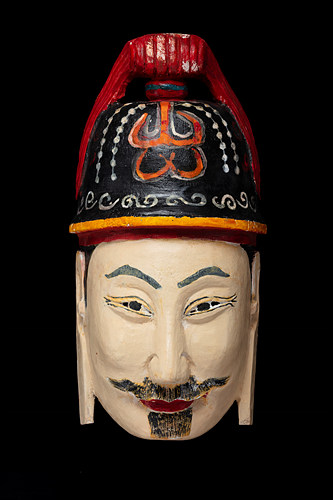
Sanjie(三界)
late 20th century It is the most revered god by Maonanzu(毛南族, a minority ethnic group that lives in Maonanzuzizhiqu(毛南族自治区), Guangxisheng(广西省). He teaches the Maonanzu(毛南族) agriculture and herding and protects the Maonanzu(毛南族).
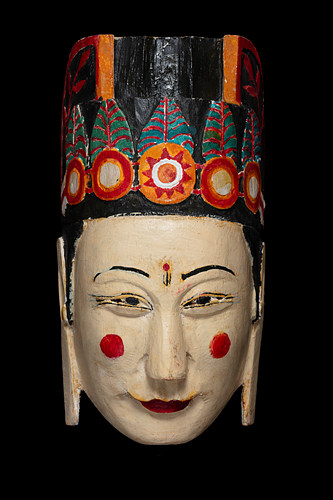
Hualinxianguan(花林仙官)
late 20th century A goddess worshipped by Maonanzu(毛南族) who helps with pregnancy and childbirth.
④ the story of a hero in history-Jiangxisheng Nanfengxian Nuowu(역사를 살았던 영웅의 이야기-강서성(江西省) 남풍현(南丰县) 나무(傩舞))
Nanfengxian(南丰县) Jiangxisheng(江西省) in China is the home of Nuowu(傩舞) and has a history of over 2,000 years of transmission. It embraces Confucianism, Buddhism, and Taoism, thus having pluralistic religious and cultural characteristics. Even now, it is performed in many villages in Nanfeng(南丰), such as Shiyoucun(石邮村) and shangganfang(上甘坊). Usually, rituals are held from Jan. 1 to 15 of the lunar calendar to gods called Nuogong(傩公) and Nuopo(傩婆). They pray for many descendants and a good harvest. It is also called Tiaonuo(跳傩) because it focuses on dances that seem to jump rather than lines.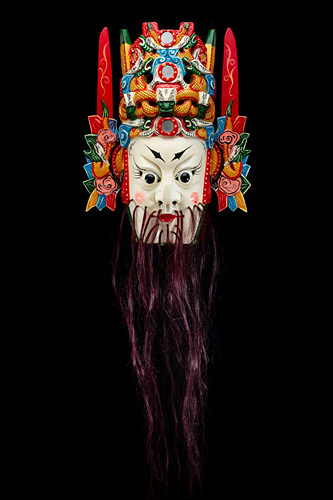
Liu Bei(刘备)
21st centuryLiu Bei(刘备) made an oath of brotherhood with Guan Yu(关羽) and Zhang Fei(张飞). And Zhuge Liang(诸葛亮) was made a military force. Later, he teamed up with Sun Quan(孙权) to defeat Cao Cao(曹操) in Chibi(赤壁, Red Cliff) and establish Shu Han(蜀汉).
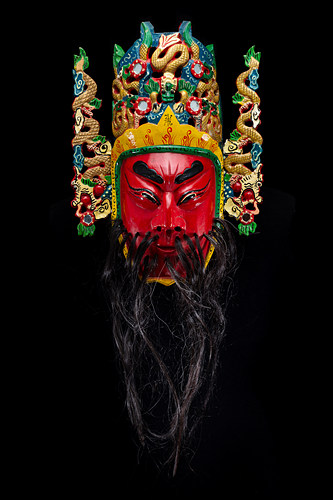
Guan Yu(关羽)
late 20th century Guan Yu(关羽) is a hero who helped Liu Bei(刘备) to win several battles, and is considered a symbol of loyalty and the god of wealth.
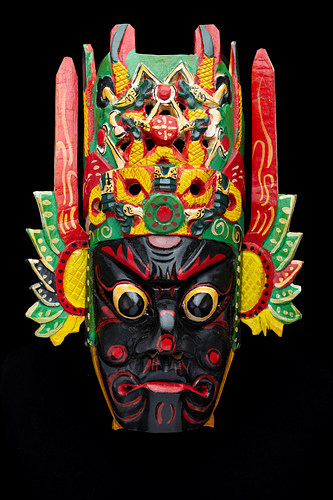
Zhang Fei(张飞)
late 20th century Zhang Fei(张飞) made a brotherly pact with Liu Bei(刘备) and Guan Yu(关羽). And he was valiant in many wars. That's why he is referred to as the general of Shu Han(蜀汉) along with Guan Yu(关羽).
1-3. The story of prayer(기도하는 이야기)
When there is a difficult task that cannot be solved by human power, pray that all difficulties will be solved and that all wishes will come true. Prayer to God is sometimes expressed as a group's religious ceremony or festival in contact with the community's desire. Japanese mask plays are performed as a process of rituals offered to God. Mask plays that accompany God and imitate God are individuals and groups' prayers that wish will come true in return for entertaining God. God has various faces, including a mythical god, a religious god, a natural god, and an ancestral god. There are believers who come only on very special days to bless people.Kagura(神楽, Japanese mask plays) is usually performed one night in winter(November to February). November of the lunar calendar is a season when the energy of everything weakens, and night is a time of yin when darkness dominates. On the other hand, it is also a hopeful time to prepare for the new spring and morning. Kagura(神楽) is held all night long on cold winter days. They invite God to pray for him and offer him praise, and they meet with him and pray for a desire. They spend the darkness praying for God and hope for brightness, have an old year and a new year. God responds to the continuous prayer with the sound of a drum that makes your heart beat with the blessing of weak energy and regenerating the soul. When the night of prayer passes and the morning comes, people are reborn with new energy and heart. Kagura(神楽) becomes both a story of God and a prayer for a living person who wishes for a peaceful tomorrow.
① Kagura(神楽)
Kagura(神楽), performed around Shrine(神社), is one of Japan's oldest folk entertainment, and numerous Kagura(神楽) are handed down from all over the world. Representatively, there are Yamabushi Kagura(山伏神楽) in the Northeast region, Hana Matsuri(花祭) in the East Sea region, and Aragami Kagura(荒神神楽) in the western part of Japan(西国) region. Most of them are prayers to gods related to livelihood and production, such as agriculture, fishing, and hunting. Kagura(神楽) is the driving force to live a hard year by delighting God and enhancing the weakened human vitality.㉠ Welcoming Deities(迎神)
The Kamigoto Kagura(上五島神楽) is performed around the Aokata Shrine(靑方神社) of the Goto Islands(五島列島) of Nagasaki Prefecture(長崎県). It performed twice, in summer and winter, and it means to pray for a good harvest in summer and for the New Year in winter. Especially in winter, Kagura(神楽) is considered a village festival and a family event where even villagers who went out of town return to their hometowns and participate.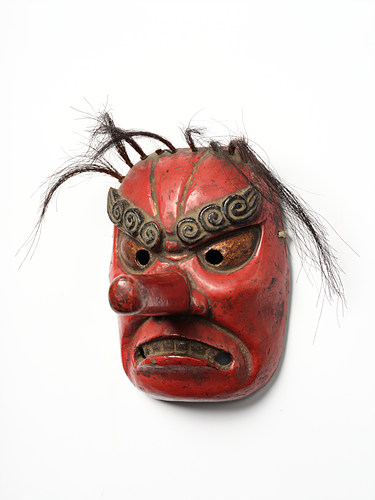
Tengu(天狗)
early 20th centuryJapan National History and Folklore Museum
It is a mask that appears in the street parade of Kagura(神楽). It is similar to the Malttugi mask in Korea, which has a large nose in that it symbolizes strong power and masculinity in the form of a high and long nose with a red face.
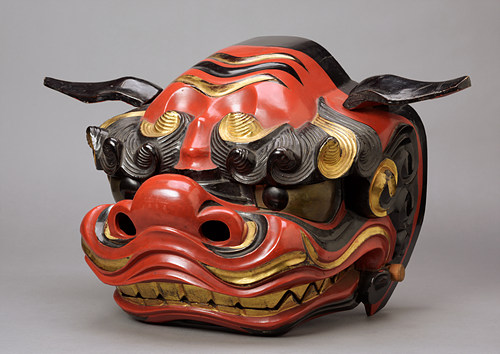
Lion(獅子)
early 20th centuryJapan National History and Folklore Museum
In Kagura, lions usually play a role in defeating the bad. The term しし, referring to lions, is an incarnation of God and a term for sacred animals. It refers to a wide range of animals, including lions, deer, and wild boar.
㉡ The God of Shintoism– Binchu Kagura(신화의 신 – 빗추가구라(備中神楽))
Binchu Kagura(備中神楽) is passed down mainly in the Binchu(備中) area of Okayama Prefecture(岡山縣). It is mainly performed from autumn to winter. Myths such as 'close to rock door opening(岩戸開き)'* are performed as mask plays.* When Amaterasu(天照大神) hid in a cave(岩戸) due to the violence of Susanoo(須佐男命), darkness fell on the world. To solve this problem, Amenouzume(天鈿女命) performed an possessed dance
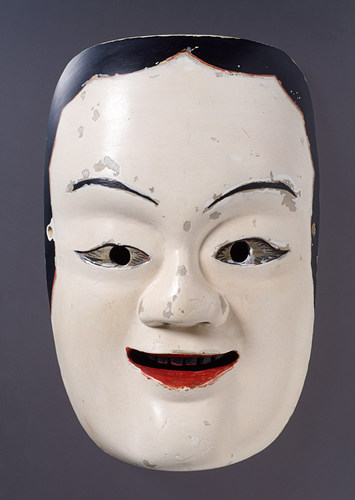
Amaterasu(天照大神)
late 20th centuryJapan National History and Folklore Museum
She is the highest of the 8 million gods in Shinto, Japan, and is the sun goddess.
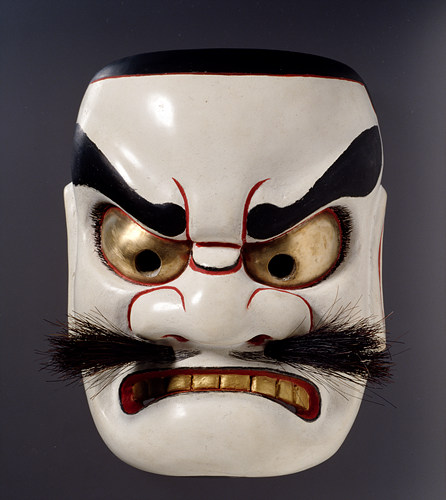
Susanoo(須佐男命)
late 20th centuryJapan National History and Folklore Museum
Amaterasu(天照大神)'s brother, the god of the sea and the god of storms
㉢ The Gods of various provinces(지역의 신)
- Hana matsuri(花祭)
The Hana matsuri(花祭) is a traditional Kagura(神楽) performed mainly in many mountain villages in northeastern Aichi Prefecture(愛知県), and is held throughout the night from November to New Year. It is meant to pray for the maturity of human life as if flowers bloom. Depending on the village and religion handed down, the process, mask shaping, and stage style are slightly different, but it is the same as applying to pray for fulfillment of wishes, exorcism, mental and physical vitality and boiling water in a large cauldron and offering various dances to God.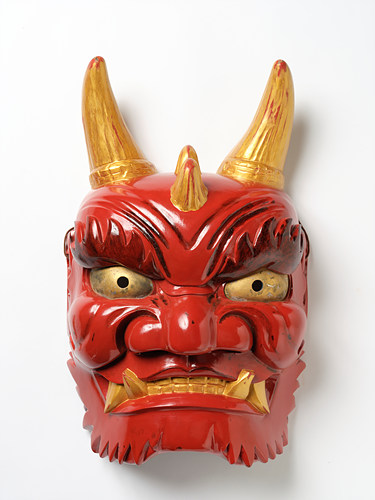
Yamami Oni(山見鬼)
late 20th century Japan National History and Folklore Museum
The Ghost Mask at the Hana matsuri(花祭)
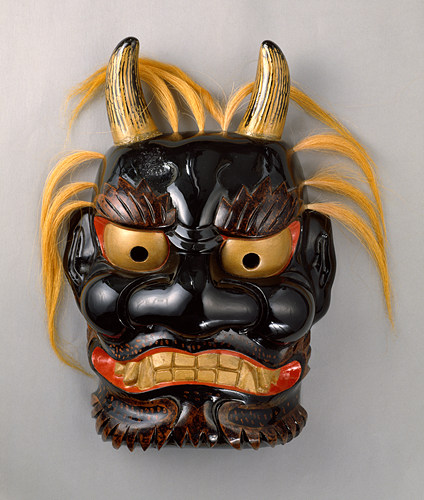
Sakaki Oni(榊鬼)
late 20th century Japan National History and Folklore Museum
A mask of a mountain god who is the main god of the Hana matsuri(花祭) and breathes new vitality and vitality into the earth
- Hayachine kagura(早池峰神楽)
It is a Kagura(神楽) handed down from Hanamaki City(花巻市), Iwate Prefecture(岩手県), and is taken away mainly at the shrine's annual grand festival held in summer. From December to January, he performs kagura every night while walking around the town praying for a disease-free life. Hayachine kagura(早池峰神楽) contains the piety of the village's sacred mountain, and a mask depicting a mountain god appears as the main character.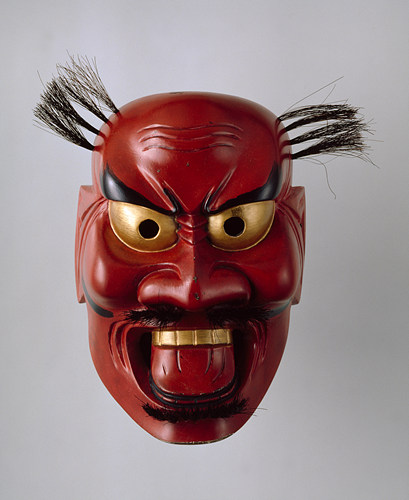
Yamanokami(山之神)
late 20th century Japan National History and Folklore Museum
A mask of a mountain god that exorcises evil spirits and brings about a good harvest
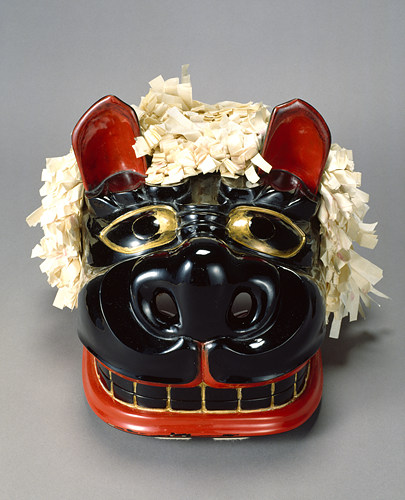
Lion(権現様)
late 20th century Japan National History and Folklore Museum
A lion mask that repels all kinds of disasters and gives villagers a safe life
② Visiting god(來訪神)
Visiting God is a God who is believed to visit the human world from another world at a fixed time on an annual day (usually the beginning of the new year, such as Lunar New Year's Day) to ward off evil. It is said that he comes to this world at a fixed time, mainly beyond the horizon or deep in the mountains. There is a strong belief in Visiting God that gods living in other worlds visit Okinawa(沖縄) to bring happiness such as a good harvest of rice. Visiting God of Hateruma Island(波照間島) are Miroku(弥勒), Fusamara(フサマラ), Angama(アンガマ), etc. on New Year's Day and Obon.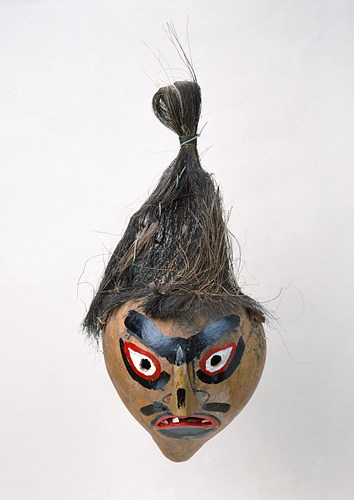
Fusamara(フサマラ)
late 20th century Japan National History and Folklore Museum
Mask of a God to solve a drought

Miroku(弥勒)
late 20th century Japan National History and Folklore Museum
Mask of God that brings happiness
③ Noh(能)
Noh is an aristocratic performance with distinct Japanese characteristics, and it is a mask play in which characters wearing masks and colorful costumes unfold their stories with lines and dances to Utai(謡), a vocal music accompaniment with lyrics. Noh plays five squares at a time of performance, which is called Gobantate(五番立).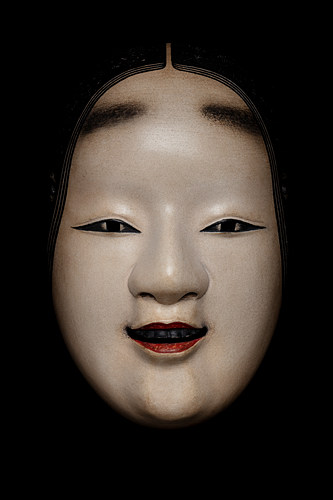
Ko-omote(小面)
21st centuryMask of a young woman's character
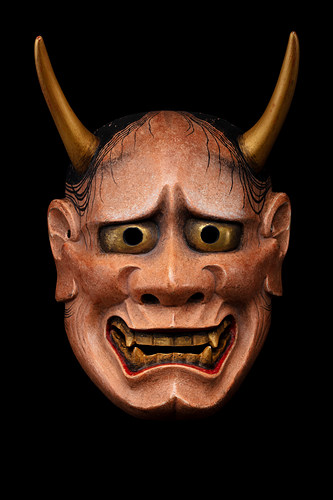
Hannya(般若)
21st centuryA ghost mask filled with jealousy and resentment